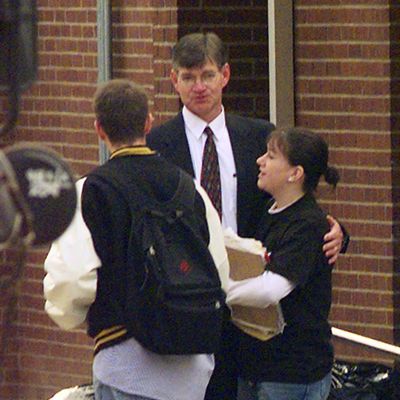
Bill Bond, specialist for school safety at the National Association of Secondary School Principals, has spent more than a decade speaking and consulting on school violence. Here, he tells assistant editor Eric Benson about lockdown procedures and the deadly shooting he witnessed himself.
Along with Columbine, my school is the reason lockdown procedures came into being. I was principal of Heath High School in Paducah, Kentucky, and we had eight shot in the lobby; three girls were killed. Back then, we had a crisis plan for the school, but what we were thinking about was a school intruder — an irate person, a mad parent, someone like that. We weren’t thinking about guns at all.
A lockdown means that all students get to the nearest classroom, regardless of whether it’s theirs or not, as quickly as possible. You lock the doors. You pull the shades. You turn the light out. You have the kids move to the back corner of the room, away from the door and windows. And you get the kids to be as quiet as possible. You want them to be quiet, because shooters react to sound and movement. If there’s someone screaming and hollering or running around, the shooter is much, much more likely to try to enter that door.
I know, in my personal situation at Heath High School, all the kids shot were moving. The ones that didn’t move weren’t shot. These shooters aren’t trying to kill any one person. They’re just trying to kill people, and it’s the movement that attracts the shots. I can’t fully explain it to you unless you’re a hunter — or if you’ve ever watched a cat play with a mouse. As long as the mouse lays perfectly still, the cat’s just perfectly content to look at the mouse. If the mouse tries to escape, the cat instinctively reacts.
I remember going up to Red Lake, Minnesota, after the shooting there. Red Lake was an exact parallel to what happened at Newtown. The shooter killed his grandfather, took his grandfather’s police weapons, his grandfather’s bullet-proof vest, and went to the local school and just shot his way in.
I will never forget talking to Ron Kingbird, who was a teacher there. The school was locked down, and that shooter was walking up and down the hall firing hundreds of shots. The lights were out, and the kids in Ron’s classroom were down on the floor. I was in that classroom with Ron, and he was showing me where the kids had been. Ron said he had his back to the door — he was within two inches of that door — and then the shooter twisted and shook the door handle. The kids were real quiet, and the shooter just moved on.
Now, say there’d been a lot of commotion and screaming in the room, the shooter probably would have blown the windows out and reached around and unlocked the door. That’s what he did in another classroom. He shot the teacher. Then as the kids begged for mercy on the floor, he just shot them. These were Ojibwe Indians, just like he was — people he’d known all his life in that small community, and he just shot them on the floor.
At Heath, I confronted the shooter. I’d already had three kids die right in front of me. I had to try something. I just walked straight toward him. I didn’t panic. I didn’t run. That’s it. And it worked. He gave me the gun, and then I took him into my office.
But it doesn’t work very often. I’m sure the principal at Newtown had the same idea. She went out there to try to take that gun away from him, and she died. She did everything she could. When you stand in front of somebody and die, that’s it. That’s all you can do.
I haven’t done anything for the past fifteen years except go to the sites of school shootings and think about school shootings. I’ve been in the situation too much. We just don’t have an alternative to a lockdown. I mean, I just don’t see what else we can do.
A version of this article appears in the December 31, 2012 issue of New York.





























